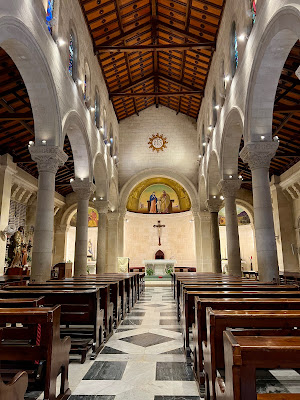Today we moved from our hotel in Tiberias on the Sea of Galilee, to our new accommodations at the King David Hotel in Jerusalem. Along the way, we toured several significant biblical sites. But honestly, you couldn't toss a stone without it hitting something noted in the Bible.
En route through Galilee we passed through Cana, the site of Jesus' first miracle. In the beginning of John 2, Jesus attends a wedding with his mother and disciples. When the wine runs out, Jesus turns the water-filled vessels to wine. What Jesus did here in Cana of Galilee was the first of the signs through which he revealed his glory; and his disciples believed in him. (John 2:11). Our first stop of the day was at Nazareth's Basilica of the Annunciation.
This modern Church of the Annunciation was built over the cave that tradition holds to be the home of the Virgin Mary. The Bible describes how an angel told the teenaged Mary that she would become the mother of the Son of God (Luke 1:26-38). This site actually contains two churches, the upper one being the parish church for Nazareth's Catholic community, while the lower one is a shrunken grotto that is the traditional cave-home of the Virgin Mary.
The cave is flanked by remnants of earlier churches on the site. Inside the cave stands an altar with the Latin inscription, "Here the Word was made flesh". The house of Mary is believed to have been converted into a church on this site around 427 AD. The crusaders built a huge basilica on its ruins. Excavations for the modern church revealed the remains of the ancient village of Nazareth, including a synagogue or shrine that predates the 427 building. This church above a church was designed by an Italian architect in order to preserve and celebrate the remains of previous worship sites. Behind the main altar is a huge mosaic, one of the biggest in the world.
Our next tour was at the adjacent, and decidedly more modest church of St. Joseph. Though there is no evidence to support it, this is celebrated as the site of Joseph's workshop. It is built atop the remains of an ancient Crusader church and over a cave system.
As we walked through Nazareth, I spied a Christmas shop. Unfortunately, I didn't have time to swing through for a look since we were on a tight touring schedule.
We zipped through the Greek Orthodox Church of the Annunciation. This church sits above the spring where it's celebrated as the place that the angel appeared to Mary. The first church was probably built on this site in the 4th century. The Crusaders built another church on its ruins at the beginning of the 12th century. However, it was destroyed by the conquering Mamluks. The current church dates back to 1750. Though under renovation, I found it to be a beautifully decorated sanctuary, particularly the second picture below of the pulpit as seen from below.
After a late lunch, we got back on the road for our last tour of the day at Beit Shean. One of the oldest cities in Israel, it's also one of the country's largest archaeological sites.
This area was originally settled about 6000 years ago and has been continually inhabited since then. Excavations of part of the large mound, or tell, in the background of the above pic revealed over twenty layers of remains from ancient civilizations. Its Canaanite temples pre-date Egyptian occupation of the region, followed by Israelite rule and the Philistines during the Old Testament period. Ancient Beit Shean is mentioned in the Bible many times, including in the book of Samuel as a city on whose walls the corpses of King Saul and his sons were displayed.
The remnants of its original mosaic floors were really impressive.
Beit Shean was a significant metropolis during the reign of Kings David and his son Solomon. During the Hellenistic period, it was renamed Scythopolis. In the first century AD it became a flourishing multicultural Roman city, one of the most important of the ten in the Decapolis, and was a provincial capital in the 4th century. It was destroyed by Assyrians in 732 and suffered further ruin during an earthquake in 749, thus never regaining its former status. You can still see some of the columns that were toppled by the ravages of conquering armies and natural disasters and never rebuilt.






























No comments:
Post a Comment